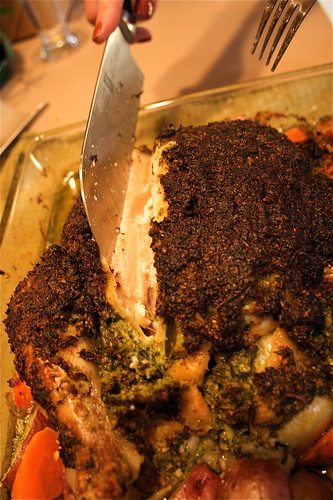 So, wow. Life has been eventful. Between getting married (good) and the electrical grounding cable to our entire house snapping (bad, so very bad) it's been tough to scrape a post together. Not that we've given up cooking, far from it! But blogging about cooking has a long list of tasks involved; in order to make recipes coherent requires us to be prepared or something approximating it. My computer got fried in a single stenchtastic zap (yes, it DID have a surge protector on it, you all can quit asking me that any time). So right now, the only thing I can prepare for on my little borrowed laptop computer is long periods of staring at the spinny rainbow circle OOOH SO PRETTY, the rainbow ball, it's still spinning!
So, wow. Life has been eventful. Between getting married (good) and the electrical grounding cable to our entire house snapping (bad, so very bad) it's been tough to scrape a post together. Not that we've given up cooking, far from it! But blogging about cooking has a long list of tasks involved; in order to make recipes coherent requires us to be prepared or something approximating it. My computer got fried in a single stenchtastic zap (yes, it DID have a surge protector on it, you all can quit asking me that any time). So right now, the only thing I can prepare for on my little borrowed laptop computer is long periods of staring at the spinny rainbow circle OOOH SO PRETTY, the rainbow ball, it's still spinning!
 Right. It's time to take care of a few items. First on the list is a shout-out to that wonderful place and wonderful group of people, our local farmers' market. Every week brings together a new assortment of the best nature has to offer. Can anyone explain why I went to Giant (local large chain supermarket) to buy free-range organic eggs from some distributor at least a hundred miles away, when I could have bought them at the farmers' market much fresher, larger, and only twenty-five cents more per dozen? I'm all about saving money when it's possible, but that was completely irrational. Take a naughty peek at some of the lovely items we rustled up.
Right. It's time to take care of a few items. First on the list is a shout-out to that wonderful place and wonderful group of people, our local farmers' market. Every week brings together a new assortment of the best nature has to offer. Can anyone explain why I went to Giant (local large chain supermarket) to buy free-range organic eggs from some distributor at least a hundred miles away, when I could have bought them at the farmers' market much fresher, larger, and only twenty-five cents more per dozen? I'm all about saving money when it's possible, but that was completely irrational. Take a naughty peek at some of the lovely items we rustled up.
One of our favorite stands had gorgeous sweet onions: thin, papery skins, with lush, firm, clear flesh underneath. I grabbed the largest basket of them before anyone else could get there. The lady at the counter looked puzzled and mildly horrified.
"What are you making with all those onions??" The truth was, I didn't know, except that they would be used (salsa, guacamole, frittatas, casseroles, stir fry, sammitches, soups, roasts... only every main dish we make). Although onions seem like something you could easily get at your "regular" supermarket stop, I can't tell you how many times I've brought home a bag of $0.69 per pound yellow onions, or even the expensive sweet ones, to find a few days later suspicious black mold creeping through so-called "fresh" onions.
Fresh, my ass.
Forgetting about or neglecting the mold for another day or two yields a layer of liquified onion slime just beneath the layer you'd ordinarily stop peeling at. Start slicing and, surprise!! The only solution is to throw out the whole bag and cut your losses. Tell me it's not worth another dollar per pound for onions you can actually use, and don't have to throw out in disgust? I like saving money but buying poor quality produce isn't the way to do it.
Which brings me to another point, that is, saving money. There's a balance we all need to maintain between living well and also living within our means. One argument is that going completely vegetarian cuts out a large unnecessary expense; the meat counter stop. We'll agree with that. Even while agreeing with our friends the vegetarians, we also acknowledge that we're not quite ready to make it an absolute in our lives. So when we want chicken, we have chicken, and don't go crazy trying to fight it. I buy a whole, free-running and "organic" as possible chicken and we use every bit of it, partly to make up for the added expense of buying more expensive poultry, and partly because I have ingrained cheapskate tendencies. Below is the first of three recipe installments using a four-pound chicken to make three meals for three people (that's two big people and one little) without driving anyone crazy with unappetizing leftovers. Most items should be available year-round in your local market.
Meal One:
Roast herby chicken with vegetables
1 whole chicken
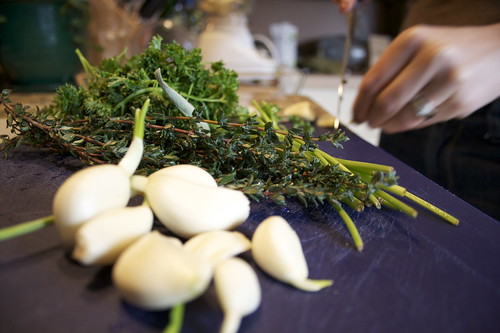 1 sweet onion, peeled and quartered
1 sweet onion, peeled and quartered
8 garlic cloves
1 or 2 celery stalks, with leaves
Mix of fresh herbs (not easy to go wrong with anything you find, but I usually have some combination of thyme, sage, rosemary, parsley, and basil)
5 small redskin potatoes, scrubbed and quartered
2 or 3 carrots, scrubbed and/or peeled, sliced
(Turnips are also good... so are sweet potatoes... or tiny boiling onions... and parsnips... butternut squash cubes... or brussels sprouts... don't be afraid to experiment, these are just the two I usually fall back on)
Sea salt and black pepper
Light olive oil
(optional) 1/2 cup white wine
Have one large glass oven baking dish as well as a large, heavy bottom stock pot at hand.
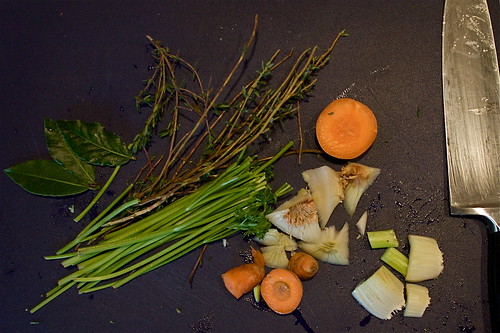 While you are preparing your roast chicken, keep an eye out for any clean bits of vegetables that you can throw into the stock pot for your soup. For example, don't throw away your parsley stems or the stalky twigs the thyme leaves grew on. They aren't pretty but there are delicious flavors contained in them. Even the tops of the carrots and the end bits of celery. Yes, it looks like something you should throw away, but we're going to take every last use out of them beforehand. Don't look at the contents of the stock pot. Just throw it all in there and trust me.
While you are preparing your roast chicken, keep an eye out for any clean bits of vegetables that you can throw into the stock pot for your soup. For example, don't throw away your parsley stems or the stalky twigs the thyme leaves grew on. They aren't pretty but there are delicious flavors contained in them. Even the tops of the carrots and the end bits of celery. Yes, it looks like something you should throw away, but we're going to take every last use out of them beforehand. Don't look at the contents of the stock pot. Just throw it all in there and trust me.
Pop the garlic cloves, one quarter of the onion, and the celery into a food processor (or chop the heck out of them to a fine crumb). When those are suitably teeny, add the herbs, salt, pepper and pulse. Add a drizzle of olive oil if needed to keep things going.
 Unwrap and rinse the chicken under cool water. Check for stray bits of ...well, anything that doesn't look like it belongs. Pull out the little baggy of "extras," remove from bag, and put them all into the stock pot without looking at them. There are some people who like to do other things with these pieces, and good for them too, but I'm not over some squeamishness about the "extras" (like, we put this chicken back together in the garage and had a few nuts and cables left over...?). I consider it a small victory to make them useful. If you are also this way, just close your eyes and throw them in the stock pot. Rinse the inside of the chicken. There, it's over. Fill your stock pot about halfway with water, add two bay leaves (they're in with your spices somewhere) and set it on a back burner on low.
Unwrap and rinse the chicken under cool water. Check for stray bits of ...well, anything that doesn't look like it belongs. Pull out the little baggy of "extras," remove from bag, and put them all into the stock pot without looking at them. There are some people who like to do other things with these pieces, and good for them too, but I'm not over some squeamishness about the "extras" (like, we put this chicken back together in the garage and had a few nuts and cables left over...?). I consider it a small victory to make them useful. If you are also this way, just close your eyes and throw them in the stock pot. Rinse the inside of the chicken. There, it's over. Fill your stock pot about halfway with water, add two bay leaves (they're in with your spices somewhere) and set it on a back burner on low.
 Put your chicken breast up (or breast down, don't flame war me) in the roasting dish and give her a good rub with your herby seasonings. If you're not a chicken skin eater, try to stuff some herbs under the skin so the flavor soaks down into the meat. Chop the remaining onion and mix with the vegetables you're using. If there is any herby mixture left, stir that in as well. Drizzle just a bit of olive oil (two or three tablespoons) over your vegetables and the white wine if you're using it. Arrange the vegetables evenly around your chicken. Sprinkle with salt and pepper.
Put your chicken breast up (or breast down, don't flame war me) in the roasting dish and give her a good rub with your herby seasonings. If you're not a chicken skin eater, try to stuff some herbs under the skin so the flavor soaks down into the meat. Chop the remaining onion and mix with the vegetables you're using. If there is any herby mixture left, stir that in as well. Drizzle just a bit of olive oil (two or three tablespoons) over your vegetables and the white wine if you're using it. Arrange the vegetables evenly around your chicken. Sprinkle with salt and pepper.
Cover with foil and bake at 375 degrees F for about an hour, uncover, then approximately 30 to 45 minutes more. A meat thermometer should read 185 degrees F and the juices should run clear when it's done. Let it settle for 10 minutes before carving.
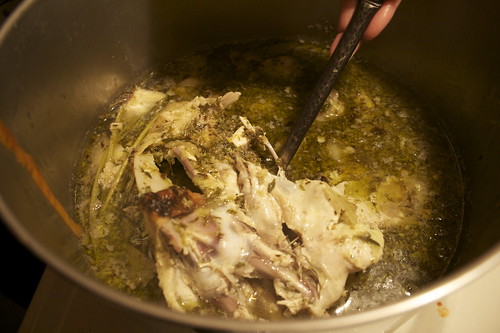 After your lovely roasty dinner, put on some romantic music, pour yourself another glass of wine (you deserve it), and take a few minutes to clean all the meat off of your chicken. It should be cool enough to handle by now. Don't try to kid yourself and say you'll do it tomorrow because you won't. When it's all cleaned, put all the bones into the stock pot with the other veggies which have been simmering happily for the last few hours. I usually put everything, skin and all, in the stock pot, because the flavors cook into the soup while the fat is easy to skim off after it cools. Cover, simmer on low (it should not be rattling the lid with a rolling boil, just an easy simmer), for at least two hours. Let it cool and "steep" for at least an hour before putting it in the fridge. Sometimes if there's a handy snow bank, we'll set the thing outside to cool further so the old fridge doesn't have to work so hard. Now, prop your feet up and forget about it for two days.
After your lovely roasty dinner, put on some romantic music, pour yourself another glass of wine (you deserve it), and take a few minutes to clean all the meat off of your chicken. It should be cool enough to handle by now. Don't try to kid yourself and say you'll do it tomorrow because you won't. When it's all cleaned, put all the bones into the stock pot with the other veggies which have been simmering happily for the last few hours. I usually put everything, skin and all, in the stock pot, because the flavors cook into the soup while the fat is easy to skim off after it cools. Cover, simmer on low (it should not be rattling the lid with a rolling boil, just an easy simmer), for at least two hours. Let it cool and "steep" for at least an hour before putting it in the fridge. Sometimes if there's a handy snow bank, we'll set the thing outside to cool further so the old fridge doesn't have to work so hard. Now, prop your feet up and forget about it for two days.
Up next, Meal Two:
Guinness BBQ chicken, rice, cheese, and baby greens warm wrap sandwiches
Then after that, Meal Three:
Soup with homemade and amazingly flavorful (without being over-salted) chicken stock
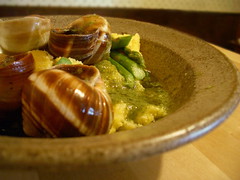 exactly at the top of many people's list of favorite foods. Maybe because it's not a common food (at least where I'm from!), maybe because it's difficult to get over the quasi-buggyness of the little creatures. I think it's a shame because when you look at what's actually in escargot, plus how it tastes, it really doesn't deserve the cringe we're probably giving it right now.
exactly at the top of many people's list of favorite foods. Maybe because it's not a common food (at least where I'm from!), maybe because it's difficult to get over the quasi-buggyness of the little creatures. I think it's a shame because when you look at what's actually in escargot, plus how it tastes, it really doesn't deserve the cringe we're probably giving it right now.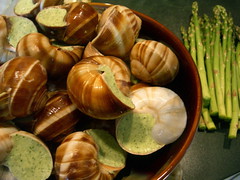 We are fortunate enough that our local farmers market fish seller carries ready-to-cook escargot stuffed with the traditional garlic-parsley-shallot butter at under $6 per dozen. The first of spring fruits and vegetables are also appearing. Here is a very easy (but impressive-looking) recipe for how I fixed them tonight:
We are fortunate enough that our local farmers market fish seller carries ready-to-cook escargot stuffed with the traditional garlic-parsley-shallot butter at under $6 per dozen. The first of spring fruits and vegetables are also appearing. Here is a very easy (but impressive-looking) recipe for how I fixed them tonight:
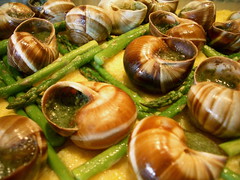 Arrange your asparagus spears and escargot (butter side up) however you like, mist lightly with olive oil then bake at 400 for about 15 minutes. The escargot should be bubbly and smell like garlicky heaven. Immediately divide into warm bowls- with a nice chunk of polenta/asparagus and six escargot on top, this recipe will serve four. The best part is that you get to pour out that lovely garlic-parsley-shallot butter stuffed into the escargot all over your polenta.
Arrange your asparagus spears and escargot (butter side up) however you like, mist lightly with olive oil then bake at 400 for about 15 minutes. The escargot should be bubbly and smell like garlicky heaven. Immediately divide into warm bowls- with a nice chunk of polenta/asparagus and six escargot on top, this recipe will serve four. The best part is that you get to pour out that lovely garlic-parsley-shallot butter stuffed into the escargot all over your polenta.





